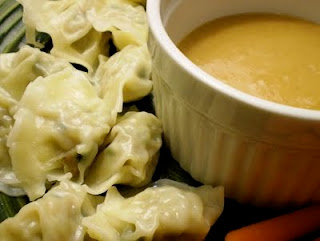Written by the fabulous Leigh, Veggie Might is a weekly Thursday column about all things Vegetarian.
I’ve been so bored by my lunches of late: repeat appearances of grain-bean-green bowls, salad after endless green salad, and I’ve been looking for something new and exciting, but simple enough to make quickly or ahead in bulk. I was seduced by the photograph accompanying this recipe Wild Rice and Edamame Salad at Chow.com.
Mmm...wild rice and edamame. So pretty! So healthy! So springy! But when I clicked through, the secondary and tertiary ingredients were woefully disappointing. Dried fruit and nuts? Five tablespoons of oil? Honey? So sweet! So oily! So blechy! (I probably hold the minority opinion here, but bear with me.)
But I was inspired. I tossed out the original recipe and recreated the dish based on what I wanted it to be: a savory and tangy, high-protein, high-fiber salad I can take to work for lunch or serve at a picnic. I replaced almost everything except the primary wild rice and edamame.
My first attempt was still a little oily (at 2 tablespoons), so I cut back even further and found success. I’d happened on fresh fava beans at my local market and thought they’d make a delicious alternative to the edamame for my second go. I was right, but here’s the thing. You really have to want fava beans.
It took me six episodes of the Big Bang Theory to shell two pounds of beans. Do you want to know the yield of my three-hour effort? One cup of fava beans and 10 pruney fingers. While the resulting salad was delicious, it was not better than the edamame version, and certainly not worth the toil if time is precious.
Third (and fourth) time was perfection. Back to edamame, I achieved the right balance of oil to lemon juice, dressing to salad, and bean to rice. And though I found my flavor grail, I think this recipe would be equally good with leeks or shallots, parsley or mint, and lemon juice or lime—whatever your taste buds desire. Maybe even dried cranberries and honey.
~~~~
If this recipe tips your canoe, swim on over to:
~~~
Wild Rice Salad with Edamame (or Fresh Fava Beans and Three Hours)
inspired by Wild Rice and Edamame Salad at Chow.com
Serves 6
1 1/4 cup edamame, shelled (or fresh fava beans, shelled and hulls removed*)
1 cup uncooked wild rice
3 cups water
1/2 cup carrot, grated
1/2 cup celery, finely chopped
1 tablespoon + 1 teaspoon olive oil
1 tablespoon lemon juice
1 tablespoon leek, minced
1 tablespoon fresh mint, chopped
2 teaspoons sea salt
1 tablespoon black pepper
*Check out this informative slide show for easy, if labor-intensive, fava bean management.
1) Cook 1 cup of wild rice in 3 cups of boiling water for 40 minutes or until fluffy and tender.
2) Make dressing by whisking together 1 tablespoon olive oil, lemon juice, leeks, salt, pepper, and mint in a large mixing bowl. Allow to meld while thawing your edamame or shelling fava beans, if you’re going the martyr route.
2a) Remove fava beans from pods, and then hulls from beans. This can take a couple of hours if you're alone. Netflix helps.
3) Quick-sautee edamame or fava beans in garlic and 1 teaspoon olive oil for 1 to 2 minutes. In a mixing bowl, toss dressing, rice, and beans with carrots and celery.
4) Serve at room temperature or chilled as a side or over salad greens.
Approximate Calories, Fat, Fiber, Protein, and Price per Serving
Edamame-style: 176.5 calories, 5.4g fat, 2.5g fiber, 3.8g protein, $49
Fava Beany: 168 calories, 4g fat, 2.3g fiber, 2.4g protein, $.61
Calculations
1 1/4 cup edamame: 236.3 calories, 10g fat, 10g fiber, 21.3g protein, $0.74
[1 cup fava beans: 187 calories, 1g fat, 9g fiber, 13g protein, $1.50]
1 cup uncooked wild rice: 571 calories, 2g fat, 0g fiber, 0g protein, $1.33
1/2 cup carrot: 26 calories, 0g fat, 2g fiber, 0.5g protein, $0.16
1/2 cup celery: 6 calories, 0g fat, 1g fiber, 0g protein, $0.08
1 tablespoon olive oil: 159.6 calories, 18.6g fat, 0g fiber, 0g protein, $0.11
1 tablespoon lemon juice: 6 calories, 0g fat, 0g fiber, 0g protein, $0.12
1 tablespoon leek: 54 calories, 0g fat, 2g fiber, 1g protein, $0.25
1 tablespoon fresh mint: 0 calories, 0g fat, 0g fiber, 0g protein, $0.04
2 teaspoons sea salt: negligible calories, fat, fiber, protein, $.02
1 tablespoon black pepper: negligible calories, fat, fiber, protein, $.02
TOTALS (with edamame): 1059 calories, 32.6g fat, 15g fiber, 22.8g protein, $2.87
PER SERVING (TOTALS/6): 176.5 calories, 5.4g fat, 2.5g fiber, 3.8g protein, $49
TOTALS (with fava beans): 1010 calories, 23.6g fat, 14g fiber, 14.5g protein, $3.63
PER SERVING (TOTALS/6): 168 calories, 4g fat, 2.3g fiber, 2.4g protein, $.61
















 2 cups plain lowfat yogurt
2 cups plain lowfat yogurt

